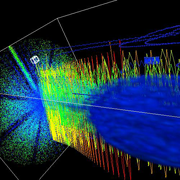Accelerator
Particle accelerators are essential scientific discovery tools for DOE. They are also very expensive machines to build, and DOE's Accelerator Modeling program aims to minimize the cost of the physical device through modeling and simulation to produce the best possible design.
The aims are:
- to locate and track "interesting particles" - those with abnormal energy level or electrical charge;
- to compute and display statistical values of various fields associated with "interesting particles" both statically and over time;
- to perform comparative visualization and analysis showing both raw and statistically summarized fields (temperature, electrostatic charge) of subsets of particles and field points;
- a stable, consistent data I/O library and format for use by the entire community;
- domain specific visualization techniques, e.g., "frequency maps" that show a particles harmonic frequency as it goes around the beamline over time;
- robust charting/graphing capability;
- the ability to do temporal visualization and analysis;
- all these features in a free, easy-to-use, extensible application that can be used by the entire community.
See Gallery: Accelerator
|

Electron Cloud simulation: trajectories of electrons as the simulation progresses rendered as splines colored by the magnitude of the velocity. A.Adelmann, PSI
|












